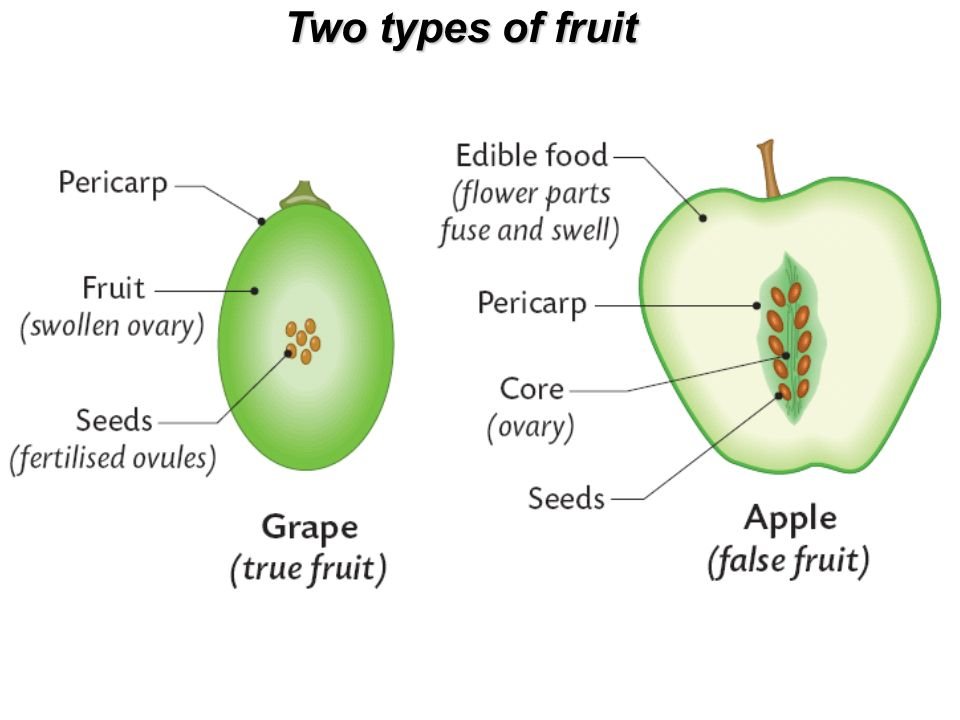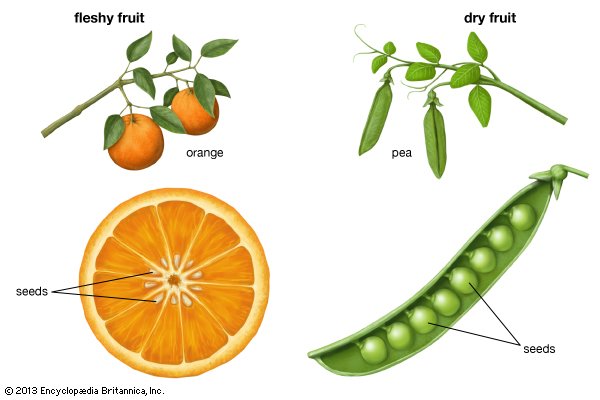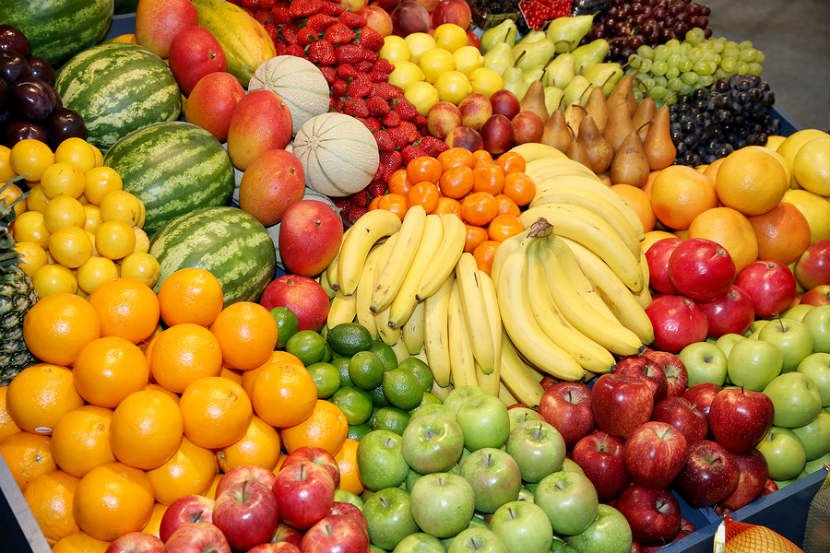Back to: BIOLOGY SS3
Welcome to class!
In today’s class, we will be talking about the fruit (structure, types, dispersal of fruits and seeds). Enjoy the class!
The Fruit (Structure, Types, Dispersal of Fruits and Seeds)
CONTENT
- Structure of a fruit
- Types of fruits
- Dispersal of fruits and seeds
- Features that aids methods of dispersal
Structure of a fruit

The fruit is a matured fertilized ovary of a flower containing one or more seeds. Contrary to this, some plants do not undergo fertilization for the formation of their fruit. Such fruits are called parthenocarpic fruits e.g. banana and pineapple. Such fruits are seedless.
A typical fruit has the following parts
- The fruit wall called pericarp which is made up of three layers from the inside to the outside (epicarp, mesocarp and endocarp).
- The seed or seeds.
- The fruit stalk-the point of attraction between the fruit to the plant.
Evaluation
- What is a fruit?
- Describe the structure of a typical fruit
Types of fruits
Fruits are classified based on their origin or structure. Common ways of classifying fruits are
- True and false fruits
- Simple, aggregate and composite fruits
- Fleshy and dry fruits
- Dehiscent and indehiscent fruits
True and false fruit:
A true fruit develops from a fertilized ovary and it contains a pericarp and seed(s) e. g. mango, cowpea while a false fruit develops from the ovary and other floral parts e. g. apple, cashew.

Simple, aggregate and composite fruits:
A simple fruit develops from a single flower with a single ovary e. g. cowpea, maize. An aggregate fruit develops from a single flower with several ovaries (each ovary develops into a fruitlet to form a cluster). The fruits have a common fruit stalk e. g. custard apple, strawberry. A composite fruit develops from an inflorescence e. g. fig, breadfruit.
Fleshy and dry fruits:
A fleshy fruit is a fruit that has the whole pericarp or at least one of the pericarp thick, soft and succulent is fleshy. There are six types of fleshy fruits:
- Drupe: A true, simple fruit with a thin epicarp, fleshy or fibrous mesocarp and a hard and woody endocarp which encloses the seed(s) e. g. mango, coconut, oil palm fruits.
- Berry: A true, simple fruit with a thin epicarp and succulent, edible mesocarp and endocarp e. g. tomatoes, guava etc.
- Hesperidium: A special type of berry in which the epicarp and mesocarp are fused together and the endocarp forms distinct chambers filled with succulent hairs e. g. oranges, lemon, grapes etc.
- Pome: A simple, false fruit in which the fleshy edible part is derived from the receptacle and the core enclosing the seeds from the ovary e. g. apple and pear
- Sorosis: A composite, false fruit formed from a dense inflorescence e. g. breadfruit, pineapple
- Syconium: A composite false fruit that develops from a cup-like inflorescence enclosing numerous tiny male and female flowers e. g. fig.
Dry fruit is a type of fruit in which the pericarp becomes dry, hard, woody or fibrous when the fruit ripens. Dry fruits can be grouped into dehiscent or indehiscent fruits

Dehiscent fruits and indehiscent fruits:
Dehiscent fruits split open to release the seeds when ripe. Four main types are
- Legumes: The pericarp split open longitudinally along both side to release the seeds e. g. cowpea. Flamboyant etc.
- Follicle: The pericarp split open longitudinally on one side only to release the seeds e. g. silk cotton, kola
- Capsule: The pericarp slit along many sides to release the seeds e. g. Okro, cotton, etc.
- Schizocarp: Breaks up into units enclosing one seed each e. g. desmodium, cassia etc.
Indehiscent fruits fall to the ground when ripe, eventually decayed to release the seeds. Five main types are
- Achene e.g. clematis
- Cypsela e.g. Tridax, sunflower, marigold
- Caryopsis e.g. maize, rice
- Nut e.g. cashew nut
- Samara e.g. combretum
Evaluation
- Differentiate between a) true fruits and false fruits b) simple, aggregate and composite fruits
- Mention five types of dry dehiscent fruits with one example each
Dispersal of seeds and fruits
This is the transfer of the seed or fruit from the parent plant to other places where such seed may germinate. The essence of dispersal includes the following:
- To avoid undue competition for nutrients, light space and water
- To prevent overcrowding of plants
- To prevent the spread of disease
- To encourage colonization of new area for such plants
Agents of dispersal
These are how seeds and fruits are removed from parents to other places. These agents include:
- wind
- water
- animals and man
- explosive mechanism
Features that aids methods of dispersal
- Wind: (i) Fruits or seeds are light. (ii) Fruits or seeds may have floss, tuff or pappus e. g. tridax, cotton, combretum etc.
- Water: (i) Light fruits or seeds that can float in water (ii) Waterproof epicarp (iii) Fibrous mesocarp that can trap air to keep it afloat e. g. coconut
- Animals and man: (i) The fruits or seeds may have hooks or hairs to attach to the animal skin (ii) The fruits are edible and the seeds indigestible e. g. pepper, desmodium
- Explosive mechanism: (i) Presence of one or more lines of fission or weakness e. g. cowpea, flamboyant, Okro etc.
Evaluation
- Mention five importance of fruits and seeds dispersal
- State two features each that aids wind and water dispersal
General evaluation
- What is a fruit?
- Describe the structure of a fruit
- Differentiate between a simple, aggregate and a false fruit
- Differentiate between a true and a false fruit
- Classify fruits into dehiscent and indehiscent fruit giving one example in each case
- Give two features each of fruits dispersed by water, wind and animals
- Differentiate between a drupe and a berry
Weekend assignment
- A fruit that develops from the ovary and other floral parts is called a __________ fruit A. true B. aggregate C. false D. simple
- A fruit that develops from an inflorescence is known as a _____________ fruit A. aggregate B. simple C. composite D. true
- Which of these is not a class of dry dehiscent fruits A. legumes B. follicle C. capsule D. cypsela
- The following except one belong to the same class of fleshy fruits A. coconut B. apple C. oil palm fruit D. mango
- The following are dispersed by explosive mechanism except for _______ A.tridax B. cowpea C. flamboyant D. Okro
Theory
- Differentiate between a fruit and a seed
- With the aid of a labelled diagram, differentiate between a drupe and a berry.
In our next class, we will be talking about Variation in Population (Morphological, Physiological, Application). We hope you enjoyed the class.
Should you have any further question, feel free to ask in the comment section below and trust us to respond as soon as possible.


What are the uses of fruits
Is tomato a fruit or a vegetable
Tomatoes are fruits that are considered vegetables by nutritionists. Botanically, a fruit is a ripened flower ovary and contains seeds. Thus, roots, tubers, stems, flower buds, leaves, and certain botanical fruits, including green beans, pumpkins, and of course tomatoes, are all considered vegetables by nutritionists. But Tomatoes are fruits
Fruit
A vegetable
It’s okk
What is the difference between fruit and vegetables
importance of dispersal of fruits and seeds
What is the meaning of flanboyant
IS there no answer